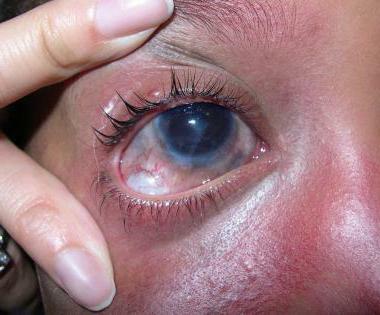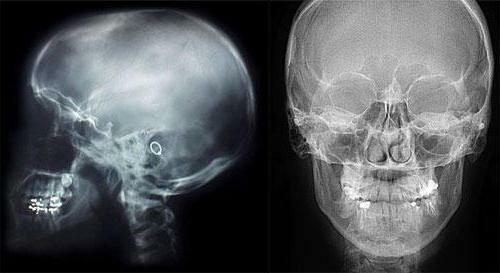What pathology is called Weber's syndrome? Weber's syndrome: causes, signs and treatment
Sturge-Weber Syndrome is a hereditary disease belonging to the group of alternating syndromes. It combines the defeat of the cranial nerves from the side of the hearth and the disturbance of the sensory and motor functions on the opposite side. Weber's syndrome is called a neurologic syndrome, in which the spine or the nucleus of the oculomotor nerve is damaged. Characteristic manifestations of the disease are reflected on the face, on the side of the focus there is ptosis, mydriasis, strabismus, contralateral central hemiplegia, paralysis of the muscles of the face and tongue.
Weber Syndrome: signs of
Weber's syndrome is a disease in which appear on the affected areas of the skin of the angioma, angiomas of the vessels of the eye and conjunctiva are also observed;possibly the development of cataracts, glaucoma, as well as detachment of the retina.
 Multiple angiomas are formed on the pia mater, which also spread to the face and adjacent tissues, with characteristic neurological symptoms. Most often the disease affects the area of the upper jaw and the ocular trigeminal nerve. Damages to the soft shell of the brain can be either only on one side, or affect both.
Multiple angiomas are formed on the pia mater, which also spread to the face and adjacent tissues, with characteristic neurological symptoms. Most often the disease affects the area of the upper jaw and the ocular trigeminal nerve. Damages to the soft shell of the brain can be either only on one side, or affect both.
The affected area of the face is covered with specific spots of red, while in addition to the nervous system, the disease can affect the internal organs.
Weber's syndrome is characterized by the following manifestations:
- MRI or CT scans are manifestations of leptomeningeal angioma.
- Convulsive reactions.
- Delay of mental development( idiocy, oligophrenia).
- Increased intraocular pressure.
- Deficiency of vision.
- Hemiparesis.
- Gemiatrophy.
- Angiomas( the skin is covered with red vascular spots).
Species of the Weber Syndrome
 There are several main varieties. Above is the described disease - Weber's syndrome. The photo shows how a person suffering from this pathology looks. The disease is divided into:
There are several main varieties. Above is the described disease - Weber's syndrome. The photo shows how a person suffering from this pathology looks. The disease is divided into:
- Schirmer-syndrome - the development of early glaucoma with manifestations of cutaneous and ocular angioma.
- Milles-syndrome is the development of the hemangioma of the eye without the addition of early glaucoma with manifestations of angioma on the skin and in the eye area.
- Knud-Rrubbe-syndrome is a manifestation of angioma of the encephalotrigue.
- Weber-Dumitri-syndrome is a manifestation of epilepsy, seizures, developmental lag, hemygypertrophy.
- Jahnke-syndrome - angiomas of the skin, areas of the brain.
- Loford syndrome is an angioma of the eyeball without increasing it.
Weber's syndrome: causes of
The cause of the disease is that during the development of the fetus two germinal leaflets are damaged: ectoderm and mesoderm. The development of this disease in children is extremely sporadic. The disease is transmitted mainly by the dominant alleles, but there is also a recessive inheritance.
 The disease can develop in the fetus if, during pregnancy, it has been adversely affected. These include:
The disease can develop in the fetus if, during pregnancy, it has been adversely affected. These include:
- Smoking during pregnancy, especially in the early stages.
- Drinking alcohol.
- Drug use.
- Intoxication of a pregnant woman of various etiologies.
- Uncontrolled use of medication.
- Sexual infections acquired during pregnancy.
- Intrauterine infections.
- Metabolic disorder in a future mother( hypothyroidism).
Often the development of the disease affects only heredity. Weber's syndrome can not be infected in everyday life.
Diagnosis of the disease
The disease is diagnosed by characteristic manifestations. Part of the patient's face is subject to angiomatous changes, increased eye pressure with a possible increase in the eyeball, there are epileptic seizures. If there is a suspicion of Weber's syndrome, the diagnosis and treatment are carried out by several doctors: an ophthalmologist, a neurologist, an epileptologist, a dermatologist.
 To determine the diagnosis, an X-ray examination is necessary. On the pictures you can see the calcification of the cerebral cortex. Computer tomography gives an even more complete picture of the affected areas. In pictures taken with MRI, you can identify the thinning of the cerebral cortex, degeneration and atrophy of white matter. Hardware diagnosis is also necessary to exclude other, no less dangerous, diseases: brain tumors, abscess of the soft tissues of the brain, cysts.
To determine the diagnosis, an X-ray examination is necessary. On the pictures you can see the calcification of the cerebral cortex. Computer tomography gives an even more complete picture of the affected areas. In pictures taken with MRI, you can identify the thinning of the cerebral cortex, degeneration and atrophy of white matter. Hardware diagnosis is also necessary to exclude other, no less dangerous, diseases: brain tumors, abscess of the soft tissues of the brain, cysts.
An important role in establishing the correct diagnosis is played by electroencephalography, since it allows to determine the activity of bioelectric impulses in the brain in order to diagnose epilepsy in time. Most people with Weber's syndrome have epileptic seizures. Also, measurements of eye pressure, visual acuity, ophthalmoscopy, AV scanning are performed for the purpose of ophthalmic treatment.
Treatment of Weber's syndrome
Weber's syndrome currently has no effective treatment, and the therapy is aimed at arresting symptoms and improving the quality of life of a person. The patient is prescribed anticonvulsant therapy with the use of various drugs:
- "Depakin".
- "Carbamazepine".
- "Keppra".
- Topiramate.
- "Finlepsin".
 Quite often the patient does not respond to the treatment of epileptic seizures, then the treating doctor may be prescribed the use of several drugs. If the intensive therapy does not help, then according to the neurosurgeon's indications, surgical treatment can be prescribed.
Quite often the patient does not respond to the treatment of epileptic seizures, then the treating doctor may be prescribed the use of several drugs. If the intensive therapy does not help, then according to the neurosurgeon's indications, surgical treatment can be prescribed.
Elevated ocular pressure( glaucoma) is treated with special drops that reduce the secretion of the eye fluid. These drugs include "Timolol", "Alfagan", "Azopt", "Dorzolamide."However, this conservative therapy can be extremely inefficient, and then the only option is surgical treatment: the patient is trabeckullectomy or trabeculotomy.
Consequences and complications of
Weber's syndrome is quite a dangerous disease. In the event that the ongoing conservative or surgical treatment has not yielded results and the patient's condition has not improved, a rather unfavorable prognosis is given. Uncontrolled epileptic syndrome can lead to dementia, oligophrenia, loss of vision, and the risk of stroke increases.
Prevention of the development of the disease
Despite the fact that the disease is hereditary, preventive measures taken by a pregnant woman will significantly reduce the risk of developing the disease. Such activities include:
- Refusal of bad habits( especially during pregnancy).
- Maintaining a healthy and healthy lifestyle. Frequent walks in the open air, healthy sleep.
- The correct fractional power. Increase in the diet of foods high in fiber. Do not eat semi-finished or fried foods.
- Timely registration at pregnancy and visiting a doctor at the appointed time.
- Drug use only for the doctor's intended use.
 Weber's syndrome is a rare and dangerous disease that directly affects the quality of life of a person. Trust in doctors, timely diagnosis and the passage of a prescribed treatment can change life for the better. It is also important not to let the disease run its course and not to take medicine without prescribing a doctor.
Weber's syndrome is a rare and dangerous disease that directly affects the quality of life of a person. Trust in doctors, timely diagnosis and the passage of a prescribed treatment can change life for the better. It is also important not to let the disease run its course and not to take medicine without prescribing a doctor.
